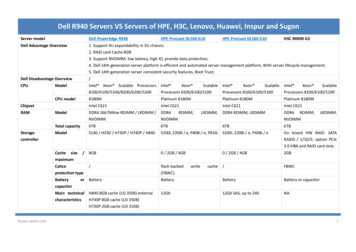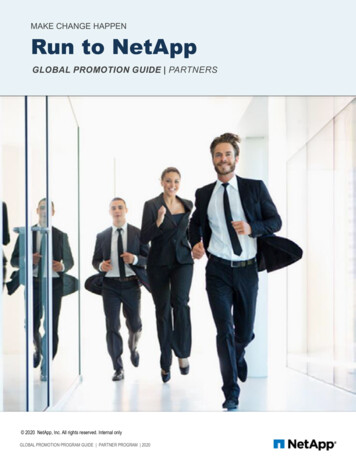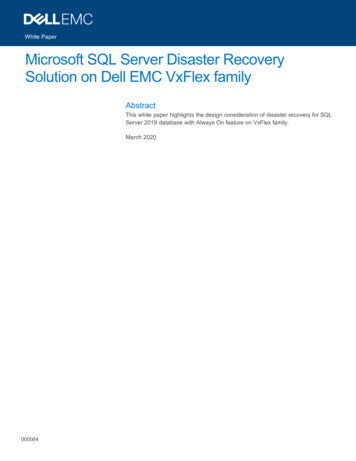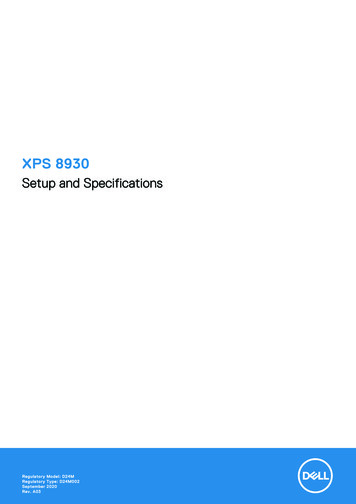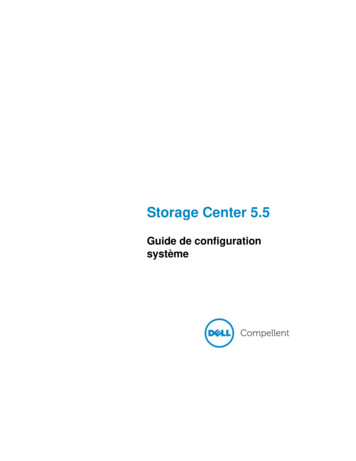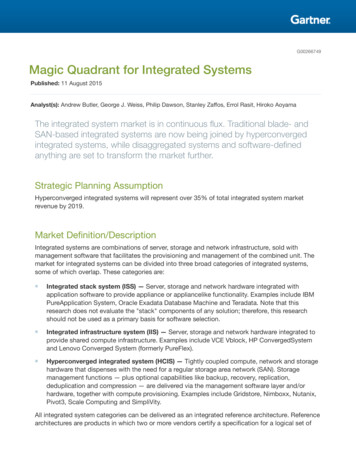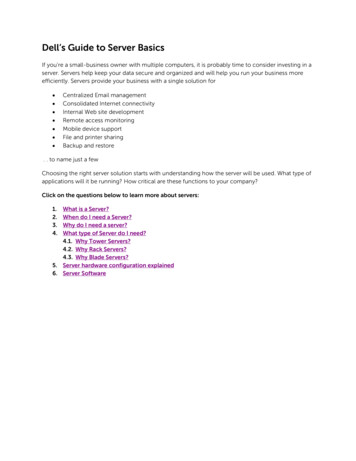
Transcription
Dell’s Guide to Server BasicsIf you’re a small-business owner with multiple computers, it is probably time to consider investing in aserver. Servers help keep your data secure and organized and will help you run your business moreefficiently. Servers provide your business with a single solution for Centralized Email managementConsolidated Internet connectivityInternal Web site developmentRemote access monitoringMobile device supportFile and printer sharingBackup and restore. . to name just a fewChoosing the right server solution starts with understanding how the server will be used. What type ofapplications will it be running? How critical are these functions to your company?Click on the questions below to learn more about servers:1.2.3.4.What is a Server?When do I need a Server?Why do I need a server?What type of Server do I need?4.1. Why Tower Servers?4.2. Why Rack Servers?4.3. Why Blade Servers?5. Server hardware configuration explained6. Server Software
What is a Server?Simply puut, a server is a typically a more powerfful computerr than your avverage desktoop. It isspecifically engineeredd to deliver innformation annd software tto other commputers that aare linked to iit bya networkk. Servers havve the hardware to managge Ethernet-ccabled or wirreless networrking, usuallythrough a router.Servers arre built to hanndle heavier workloadswannd more appllications takinng advantagee of the specifichardwaree to increase productivitypanda reduce downtime.dServers allso offer remote-management tools, whichwmeans an IT personn can check uusage, anddiagnose problems froom another loocation. Thatt also means you can perfform routine maintenanceesuch as adding new ussers or changging passworrds.Back to Top
When dod I need a server?Start by asking yourself these questions to undeerstand whenn it's time to invest in a server: Are you usingutwo or more compuuters in yourr business?By sttoring and orrganizing dataa in a core loocation, you ccan access anndshare files easily anda manage business infoormation more efficiently. Do you haveha mobilee workforce?Businesses with a mobile worrkforce (emplloyees who wwork from hoomeor frequently travvel) definitely need a serveer. Your employees canremootely connecct to the commpany networrk and accesss informationn andresources, no maatter where thhey are. Do your employeeses hare documeents between multiplecommputers? If so,, you risk losiing important files, not to mention havvingmultiplemversioons of vital doocuments. Seervers providee a centralizeed location too store andorganize impoortant documments, CanC you afford to lose valuuable files annd data?CanC it be replaaced or restoored?A server can help you get organizeodataa and helpprotect your businessbfromm lost and corrrupted files.Yoou can back up informatioon from yourr sever to adedicated bacckup and recoovery system. Then, ifsoome of your important buusiness data iss accidentlydeleted, lost oro stolen, you can be confident yourfiles are safely backed up and that you canc restorethhese files again. With the multiplemhardd drives on aseerver and youur backup sysstems, you caan becoonfident thatt a crashed haard drive wonn’t wipe outyoour system again. DoD you need tot host your own Web sitte?A Server lets you manage anda develop youryown weeb site so youu can conducct business mmoreeaasily. DoD you need tot share acceess to peripherals, such aas printers annd fax machinnes?Seervers let youur entire officce have accesss to these peeripherals. Plus, servers taake the load ooffyoour local commputer and put the jobs innto queues too print or fax next in line.Backk to Top
Why doo I need a seerver?Investing in a server ennables Yoour employees to share software toolss andacccess compaany databasess on- and offf-site. Youcaan better manage additionnal computers andsooftware applications, as wellw as controol accessthhat employeees and devicees have to cerrtaininnformation. Yoou to control access to seensitive informmation,suuch as financcial records annd personnelinnformation, byb storing it awway from pryying eyes. Italllows you to better managge firewalls and virus prottection, helping you preveent unwanteddinntrusions. Prootection is esppecially impoortant when yyou have a mmobile workfoorce. Yoou can easilyy add platformms, such as customer rela tionship mannagement (CRM) softwaree andacccounting programs, whicch enable you to schedulee group meeetings, share information, andmanagemclientts and vendorrs. They also allow your employees to send group emails and faaxesannd organize customerccontacts and cuustomer dataa in one locattion.Backk to Top
What tyype of a serrver do I neeed?The serveer you choosee should refleect the numbber and type oof applicationns you want tto run on it. YYouneed to knowkhow maany users (clients) it will have. Many coommon appliications – such as print seerving,sharing office documeents like Wordd and Excel filesf– imposee such light pprocessing deemands that asingle loww-cost serverr may be ablee to handle yoour entire co mpany with eease. Other ttasks, like hosstinglarge dataabases or imaage libraries, require moree processing horsepower along with big, fast hard ddisksand capaccious networrk pipes to match.When buyying a server there are thrree consideraations:1. Seerver type: Toower, Rack oro Blade?2. HardwareHconnfiguration3. Seerver softwarreTowers, Racks or Bllades?You can choose from the following three types ofo servers:Tower ServersSThis is thee most basic of servers onn the market. It costs and takes up as mmuch space aas the averagedesktop. TowerTserverrs are great foor small businnesses that HaveHlimited spacesconcerns and needd centralized processingwithout a data room NeedNeasier monitoringmannd maintenannce of netwoorked resourcces WantWto reducce susceptibiility to intrusion and attacck through acentral loocationA tower iss most typicaally recommeended for youur first server. You will alsoo be able to cchoose thenumber ofo hard drivess and processsors on your server.sFor ann office with less than 25 employees, aserver witth one processor and 2-4 hard drives shouldsbe suffficient. If youu have more than 25employeees or if you'ree planning to run data inteensive applicaations, a server with two pprocessors annd 46 hard driives is recommmended.Rack SeerversThis systeem stacks thee servers in raacks in much the same waay that a CD rrack stacks CCDs. This is aspace-savving option butb is more suuited for commpanies that WantWto maximmize space inn a centralized data centerr NeedNflexibilityy to mix and match serverrs to matchappplications annd workloadss Require large dedicateddstoorage internaal to the serveer.
Rack servvers are betteer for small buusinesses thaat are well-veersed in the wworld of serveers or a mediumsized bussiness that reqquires more servers.sBlade ServersThis systeem is the most compact serversof the bunch.bThis sserver was naamed for its uultrathin shappe.Multiple bladebservers can fit verticcally into a sinngle enclosurre, sharing ceertain hardwaare componeentslike poweer supplies. BecauseBof thheir ultra-commpact size, yoou can fit moore servers intto less spacee.Consolidating a traditional server infrastructuree into space- and power-ssaving blade enclosures mmeans: Moree processing Less space Less power Less time and mooney spent onn managementat for businesses that requuire much largger computinng capacity, oor for businesssesBlade serrvers are greathat plan to develop a data center.Back to Top
Server HardwareHConfiguratCtionServers usse the same basicbarchiteccture or conffiguration as your desktopp computer. HHowever, a sserverhas enhannced hardware features suuch as MultipleMmulti-core processsorsFaaster memory options forr increased appplication pe rformanceMultipleMhard drivesdfor increased data capacitycand redundancySppecialized neetworking carrds. . . and more.mSyystem boarrdThe system booard, also refeerred to as a ‘motherboarrd’, is the commputer's mainn circuit boarrd towhichwall the otherocomponents of your server are cconnected.The major commponents onn the system boardbincludee the processsor (or CPU), supportingcircuitry callede controller, and input/oud the chipset, memory, exxpansion slotss, a hard driveutput(I//O) ports for devices suchh as keyboardds, mice, and printers. Somme system booards also inccludeaddditional buillt-in features such as a graaphics adapteer, SCSI disk controller, or a networkinnterface.ProcessorPThe processorr is the centraal brain of thee server. The speed and nnumber of proocessor in yoourseerver has an enormouseimmpact on your server’s abillity to supporrt applicationns. Processorss arecoontinually chhanging and itt can be difficcult to determmine which oone is right foor your appliccation.Yoou should coonsider three main featurees when seleccting a proceessor.Clock speedsThis is how fast thee processor operates,ousu ally measured ingigaheertz (GHz). Geenerally, the faster the be tter, that is, sserverswith higher speedss deliver betteer performan ce. This mayytranslaate into the ability to suppport more simmultaneousOutloook accounts, handle moree web requessts during peaakdemannd periods orr perform faster queries o n your custoomerdatabaase. Buying a higher frequuency proces sor improvesscurrennt system perrformance buut also helps eensure your sserver is ablee to handle fuuture
demand.Core countThe number of physical processors within the processor itself. Today, most serverCPUs have two or four cores. Multiple cores enable better multitasking on servers thatwill run multiple applications. For example, virus scans may run on one core while databackup is handled by another independent core.Cache sizeEach processor has built-in high speed memory located directly on and close to thecentral processing unit (CPU). Larger cache size reduces the frequency that the CPUneeds to retrieve data from the system memory that sits outside of the CPU. For mostapplications, this improves the responsiveness of the system and provides a better userexperience. Typically, CPUs with higher core counts and frequency have larger cachesizes to provide optimal performance.MemoryWhen you open a file or document, your server needs a place to temporarily keep track of thatfile. It uses high-speed specialized chips called random-access-memory, or RAM. The actualfile is saved to your hard drive once you ‘save’ the file. RAM is designed for fast access andquickly remembers where the file is stored in your permanent hard drive system.A general rule of thumb is to add as much RAM as you can – the more RAM available, themore operations your server can handle at the same time, without having to access the harddrives (which are slower than the RAM on the system board).Storage, or Hard Drive SystemHard drives provide your server with a large library of all the files it can access. Think of it likean ever-expandable file cabinet. The size and type of hard drive systems depends on just howmuch data you need to store.Internal StorageMost servers are configured with a very large hard drive much like the hard drive inyour desktop. However, server hard drives are specially designed for fast access timesand the ability to add multiple hard drives internally.Eventually, you may need to add more hard drives and attach external hard drivesystems.RAIDRedundant Array of Independent Disks – combines hard drives into one large, logicalstorage system that writes data across more than one disk for greater reliability. Touse a RAID hard drive system, you will need to include a Dell PowerEdge RaidController (PERC) card which manages the data writing across these disks.
Network ControllerThe network connection is one of the most important parts of any server. The networkcontroller manages the inputs and traffic from the clients (other computers) in your office.Power supplyBecause a server usually has more devices than a typical desktop computer, it requires a largerpower supply (300 watts is typical). If the server houses a large number of hard drives, it mayrequire an even larger power supply.Then you need to consider which form factor options will fit your needs: Tower and Rack or Blade.Back to Top
Server SoftwareSments of a server’s operatinng system annd applicationn software difffer from those of a desktopRequiremcomputer. A server is betterbable too share data fromfmultiplee people secuurely and redduces bottlennecks.For most small to meddium business, Dell recommmends pre- installed Winndows Server 2008 family ofoperatingg systems for your server. Windows Serrver operatin g systems caan be pre-insttalled at thefactory beefore the servver is shippedd to your officce which is nnot only less eexpensive thaan purchasing atretail, butt also alleviatees the hassle of installing thet software yourself. In aaddition, pre--installed OSsoftware has been fullly tested by DellD engineerss before it leaaves the factoory and is inccluded in Delll’ssupport agreements.aCentralizedCAuthenticaationOneO of the bigggest benefitss of a server isi that it can hhouse aceentral user diirectory. It coontains the usser names anndpasswords of alla the emplooyees in the company.cAll thems on the neetwork are coonnected to t hedesktop systemseerver which allowsausers tot log into anny desktop onn thenetwork with theirtuser namme and passwword. Their fiiles andseettings will apppear as if theey were sittinng at their owwncoomputer. This functionalitty is crucial foor security anndprovides the fooundation for many otherr facets of neetworkcoomputing.Fiile SharingThe central usser directory canc also be useduto alloww or deny access to certainn files. A normmalmall‐businesss server will havehfile sharees available thhat contain uusers’ personaal files as welll assmshhared files that other users can access when necesssary. By dedicating a sharre to each user,thhey can storee sensitive andd private infoormation in a place that onnly they can access.BringingBEmmail In-Housse And Implementing Mobile E‐MMailAdding a serveer and configuring it to haandle e‐mail ttasks brings aall of your e‐mmail in‐housemakingmusers’ e‐mail access faster and keepingksens itive information within thhe company’ssdoors. In addittion, by moving your commpany’s e‐maiil to a local seerver, you can enable e‐mmailccess to yourr mobile deviices, such as a Windows MMobile phonee, BlackBerry or Dell Streaak.acCentralizedCApplicationnsAdditional bussiness applicaations such ass an inventorry or customeer resource mmanagementappplications caan be run froom your serveer and used bby your emplooyees while kkeeping the ddatasaafe on the server's redunddant storage. In most busi nesses, thesee applicationss are the key tothhe company, and keeping them safe annd sound is aan absolute reequirement, especially as thebusiness growws.
DataDBackuppOneO of the moost importantt services a seerver providees isbacking up your business criticalcdata. In the event oof aatastrophic faailure, fire, orr flood, that datadcan meaan thecadifference between keeping the doors openoor closiinghem for goodd. Backup sofftware runninng on the servverthmakesmcopies of the serverr's operating systemsand f iles tothhe tape or othher external storagesdevicce. Once commpleted,thhese backupss can be storeed off site in a secure locaation.BuildBAn Intrranet And ExtranetEA simple intrannet site for yoour business could house quick links too forms, commmonly used files,annd informatioon for your employees, ass well as servee as a central point for disstributinginnformation thhroughout thee company.VirtualizatioVonAs your server network andd infrastructure grow, youu may find thaat some of yoour servers arreunning a single applicationn. It may be usinguonly 600-70% of its pprocessing caapacity. You ccanrutaake control of this under-utilized serveer capacity byy creating virttual machinees on a singleseerver throughh a specializeed software syystem knownn as ‘virtualizaation’. So oncce you startinnvesting, you can continuee to get moree out of yourr investment wwithout adding moreinnfrastructure.If you havve. If you need.Fewer thann 15fprinters annd remote acceessShared files,usersFewer thann 75 A turn-kkey solution thaat includes sharred calendars, email, collaboration,usersremote accessaand virtuualizationA turn-kkey solution thaat includes sharred calendars, email, collaboration,Fewer thann 75remote access,avirtualizzation and linees of business aapplications succh asuserscustomerr relationship managementm(CCRM)Unlimitednumber offShared files,fprinters, virtualizationvanda remote acceessusersChooose.Winndows Server 22008R2 FFoundationWinndows SmallBusiiness Server 22008StanndardWinndows SmallBusiiness Server 20008PremmiumWinndows Server 22008R2 SStandardusiness needss to exchangee large files withw other commpanies or cclients, you caan also use yourIf your buserver to house these files and allow access to outsideoentitiies through aan extranet. MMany emailproviders restrict the sizesof emailss. Direct file trransfers may be the only wway to distribbute someinformatioonIf you're spendingsa loot of time moving information around yyour organizaation, if you’rre having trouublewringing real efficienccies out of your current coomputers, or if you have cconcerns aboout data safetty, it'stime to geet your first server.Let us shoow you how adding a servver to your smmall businesss network is ssimple with DDell.View Deell Server Soluutions
Dell’s Guide to Server Basics If you’re a small-business owner with multiple computers, it is probably time to consider investing in a server. Servers help keep your data secure and organized and will help you run your business more efficiently. Servers provide your busines

